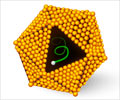Research has indicated that patients with advanced hepatocellular (or liver) cancer have high mortality rates as existing drugs confer only a small, but significant survival advantage.

Using transgenic zebrafish as an emerging, powerful whole animal model for cancer gene discovery, in combination with cultured cells and data from human tumors, they found that a gene called UHRF1, which is highly expressed in many types of cancers, can cause liver cancer at an unprecedented rate and incidence - with tumors forming in 75% of fish within 20 days. Results from the study are published online in the journal Cancer Cell.
"This is the first time that UHRF1 has been shown to be sufficient on its own to cause any kind of cancer when it is highly expressed," said the study''s senior investigator, Kirsten C. Sadler, PhD, Associate Professor Medicine in the Division of Liver Diseases and of Developmental and Regenerative Biology, and Director of the Zebrafish Research Facility at the Icahn School of Medicine at Mount Sinai. UHRF1 has generated a lot of interest because it is a central regulator of epigenome - which is a collection of reversible modifications to DNA and the DNA packaging proteins - that are important for deciding which genes are expressed and how the DNA is transmitted during cell division. The cancer cell epigenome is dramatically different from normal cells, and the field of cancer epigenetics is exploding because of the hope that these changes could be reversed, and thereby reverse the aggressive nature of cancer cells. "Down the road, we hope to develop drugs to target UHRF1 and thereby reset the cancer epigenome to activate anti-tumor mechanisms and halt liver cancer.," added Dr. Sadler.
UHRF1 Levels Important in Human Liver Cancers, Too
When the team analyzed patient-derived liver tumors, they found that high levels of the UHRF1 were also found there, too. Most strikingly, the changes in gene expression caused by high UHRF1 levels in zebrafish were reflected in the human tumors expressing high UHRF1 levels. This points to similar mechanisms underlying UHRF1-driven liver tumor formation in both species. One of these is the ability of the cancer-prone cells to bypass the tumor suppressive mechanisms that are activated in most cells when they receive a cancer-causing stimulus.
Cellular senescence is one such mechanism, and this study found that tumors associated with UHRF1 levels in both fish and humans only those cells that could escape senescence were the ones that could go on to form the tumors. This lays the groundwork to use this model to test new therapies that would target UHRF1 to re-activate the senescence program and halt cancer formation.
Advertisement
UHRF1 is overexpressed in around 40%-50% hepatocellular cancers in humans and predict poor outcome. This overexpression is associated with poorer prognosis in terms of high recurrence rate and low term overall survival. "We have little to offer people in the setting of advanced disease - and this points to an entirely new direction," Dr. Sadler said. "It raises the hope that epigenetic drugs could be applied to liver cancer in the future."
Advertisement
The need for better treatments for hepatocellular cancer was underscored by Josep M. Llovet, MD, a study coauthor, and Professor of Medicine, and Director, Mount Sinai Liver Cancer Program. "The incidence of hepatocellular cancer is increasing worldwide and the median outcome at advanced stages with the sole effective molecule available, Sorafenib, is one year. Thus, identification of novel targets for HCC therapies are an unmet medical need. The current study points to the fact that UHRF1 is an oncogene driver and a potential target for therapies."
Other researchers contributing to this research from the Icahn School of Medicine at Mount Sinai were Raksha Mudbhary, Yujin Hoshida, Yelena Chernyavskaya, Vinitha Jacob, M. Isabel Fiel, Xintong Chen, Kensuke Kojima, Swan Thung, Anja Lachenmayer, Kate Revill, Ravi Sachidananandam, and Josep M. Llovet. The research team also included investigators from Harvard Medical School''s Brigham and Women''s Hospital and the IDIBAPS- Hospital ClÃnic and Institucio Catalana de Recerca, in Barcelona Spain.
About Cancer Gene Discovery in Zebrafish
Researchers in the Liver Cancer Research Program at the Icahn School of Medicine at Mount Sinai use genetic approaches in live zebrafish and in cultured human cancer cells. They collaborate with translational researchers to exploit data from human tumors to identify novels targets for treating hepatocellular carcinoma.
About the Mount Sinai Health System
The Mount Sinai Health System is an integrated health system committed to providing distinguished care, conducting transformative research, and advancing biomedical education. Structured around seven member hospital campuses and a single medical school, the Health System has an extensive ambulatory network and a range of inpatient and outpatient services-from community-based facilities to tertiary and quaternary care.
The System includes approximately 6,600 primary and specialty care physicians, 12-minority-owned free-standing ambulatory surgery centers, over 45 ambulatory practices throughout the five boroughs of New York City, Westchester, and Long Island, as well as 31 affiliated community health centers. Physicians are affiliated with the Icahn School of Medicine at Mount Sinai, which is ranked among the top 20 medical schools both in National Institutes of Health funding and by U.S. News & World Report.
For more information, visitwww.mountsinai.org. 
Find Mount Sinai on: Facebook: www.facebook.com/mountsinainyc
Twitter" @mountsinainyc
YouTube: youtube.com/mountsinai
Source-Newswise















